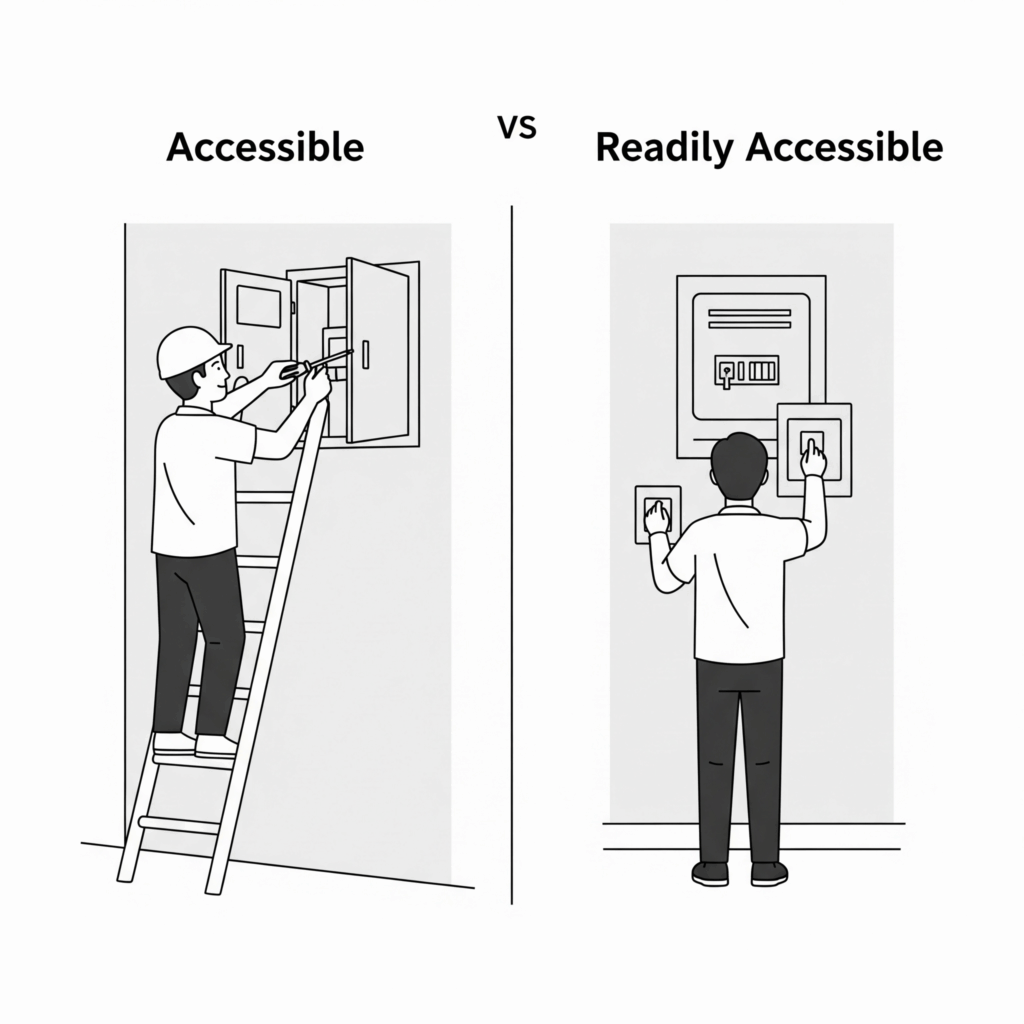What Is the Difference Between “Accessible” and “Readily Accessible”?
Introduction
Understanding the difference between accessible vs readily accessible is crucial for safe and compliant electrical installations under NFPA 70 (NEC). These terms, often confused, have distinct implications for equipment placement and safety. This guide clarifies their meanings, applications, and safety protocols for electricians. To ensure your work meets code, it’s vital to grasp the specific requirements for both terms.
Understanding the Key Terms
Accessible
Per NEC Article 100, “accessible” means equipment or wiring can be reached without damaging the building’s structure or finish, often requiring minor effort (e.g., removing a panel). This applies to areas like attics or behind a drop ceiling.
- Examples: Junction boxes behind removable panels or in attics (NEC 314.29).
Readily Accessible
“Readily accessible” is a stricter requirement under NEC Article 100, meaning equipment can be immediately reached without tools, ladders, or obstacles.

Examples: Circuit breakers (NEC 240.24), wall switches, GFCI outlets with test/reset buttons (NEC 210.8).
The Practical Difference in Installations
These definitions dictate installation practices:
- Circuit Breakers/Switches: Must be readily accessible for emergency de-energizing (NEC 240.24, 404.8).
- Junction Boxes: Must be accessible, not permanently enclosed (NEC 314.29).
- GFCI/AFCI/SPDs: Devices with user-operated reset functions (e.g., GFCI, AFCI) must be readily accessible (NEC 210.8, 210.12). Surge protective devices (SPDs) require ready access only if user interaction is needed (NEC 285).
Non-compliance risks unsafe maintenance or failed inspections.
Ensuring Safety with NEC Accessibility Rules
Adhering to NEC accessibility rules ensures safe electrical systems, enabling quick emergency access and compliant maintenance per NFPA 70 and NFPA 70E.
Code Compliance: Follow NEC to avoid inspection failures or liability.
Emergency Access: Readily accessible devices (e.g., breakers) ensure quick power shutoff (NEC 240.24).
De-energize: Verify circuits are off with voltage testers; use lock-out/tag-out (LOTO) (NFPA 70E 120.2, 120.5).
PPE: Wear insulated gloves and safety glasses for live work (NFPA 70E 130.7).
Safety Protocols
- Emergency Access: Readily accessible devices (e.g., breakers) ensure quick power shutoff (NEC 240.24).
- De-energize: Verify circuits are off with voltage testers; use lock-out/tag-out (LOTO) (NFPA 70E 120.2, 120.5).
- PPE: Wear insulated gloves and safety glasses for live work (NFPA 70E 130.7).
- Code Compliance: Follow NEC to avoid inspection failures or liability.
Conclusion
Mastering the difference between accessible vs readily accessible is fundamental for a professional electrician. By understanding and applying these NEC definitions, you can ensure systems are not only maintainable and code-compliant but also genuinely safe for both users and technicians. This commitment to detail is what separates professional work from shortcuts.
Take the next step in your professional growth! Visit Expert CE (https://expertce.com/) for all your continuing education needs.
Continuing Education by State
Select your state to view board-approved continuing education courses and requirements:
Disclaimer: The information provided in this educational content has been prepared with care to reflect current regulatory requirements for continuing education. However, licensing rules and regulations can vary by state and are subject to change. While we strive for accuracy, ExpertCE cannot guarantee that all details are complete or up to date at the time of reading. For the most current and authoritative information, always refer directly to your state’s official licensing board or regulatory agency.



